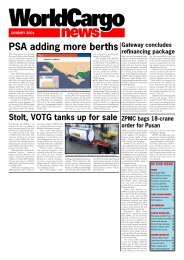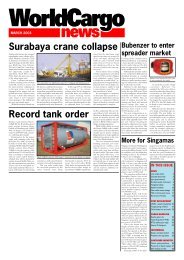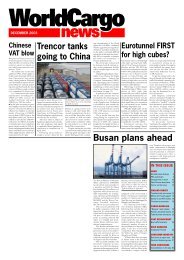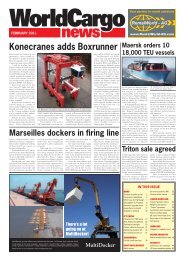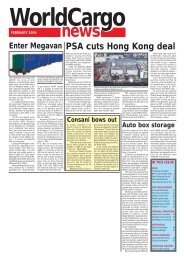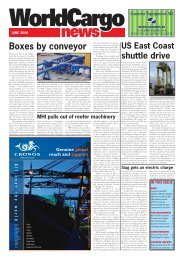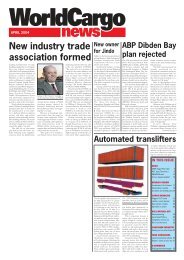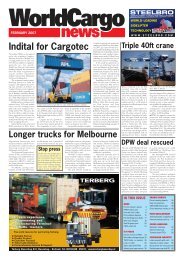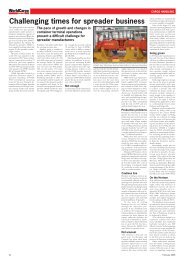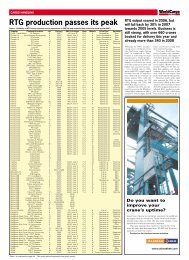Tanjung Priok super port - WorldCargo News Online
Tanjung Priok super port - WorldCargo News Online
Tanjung Priok super port - WorldCargo News Online
Create successful ePaper yourself
Turn your PDF publications into a flip-book with our unique Google optimized e-Paper software.
PORT DEVELOPMENT<br />
Port congestion crunch in Brazil<br />
In a recent re<strong>port</strong>, Brazil’s Ministry of Development,<br />
Industry and Foreign Trade<br />
stated that vessels calling at <strong>port</strong>s in the<br />
country last year spent 90% of their time<br />
either waiting for a free berth or for the<br />
arrival of an ex<strong>port</strong> shipment in the <strong>port</strong>.<br />
As a result, Brazilian <strong>port</strong>s are expensive<br />
to use and ex<strong>port</strong>s are less competitive.<br />
In Santos the average time for a vessel<br />
to be loaded with maize was 18.7 days, of<br />
which 16.3 days were down to waiting<br />
time. It was a similar position with soya<br />
bean meal and sugar, whereby 8.8 days of<br />
the total layover of 11.4 days were down<br />
to waiting time. As already re<strong>port</strong>ed in<br />
<strong>WorldCargo</strong> <strong>News</strong>, some Chinese customers<br />
have cancelled contracts for soya beans.<br />
Truck queues outside the <strong>port</strong> of Santos<br />
stretched at one point to 30 kms.<br />
This was in a year when the soya bean<br />
crop in Brazil amounted to 83 Mt. Santos<br />
has been particularly hard-hit this year because<br />
the harvests for both soya bean and<br />
maize are more than double in terms of<br />
volume than the previous year. Brazil is<br />
on target to overtake the US for the very<br />
first time in soya bean production thanks<br />
to this year’s crop, while the US has been<br />
hard hit by drought. Brazil’s <strong>port</strong> and inland<br />
trans<strong>port</strong> infrastructure is being overwhelmed.<br />
However, as the protracted debate<br />
over MP 595 shows (<strong>WorldCargo</strong><br />
<strong>News</strong>, March 2013, p23-24), there is no<br />
consensus on the way forward.<br />
Freight impacts<br />
A government official noted that the long<br />
wait for berthing directly impacts on<br />
freight rates, given that demurrage fines<br />
are contractually allocated to the Brazilian<br />
im<strong>port</strong>er or ex<strong>port</strong>er, thereby undermining<br />
profits, causing damage or even<br />
resulting in the loss of future business.<br />
The re<strong>port</strong> prepared for the Ministry<br />
says that the long stay that vessels are<br />
forced to endure “indicates a possible low<br />
operational capacity at Brazilian <strong>port</strong>s<br />
and/or low productivity im<strong>port</strong> operations.”<br />
It highlights the need for “major<br />
investment” to expand capacity.<br />
Santos is not the only <strong>port</strong> to be affected.<br />
In 2012, container vessels stayed<br />
an average of 36.3 hours in all Brazilian<br />
<strong>port</strong>s, of which 20.5 hours were waiting<br />
at anchor. At Salvador, the average handling<br />
time was 45.7 hours, of which 33.8<br />
hours was waiting time. In Paranaguá,<br />
waiting time was 25.2 hours out of a total<br />
stay of 40.9 hours.<br />
In a 2012 World Bank study, Brazil was<br />
in 121st position out of 185 countries<br />
analysed in terms of the cost of ex<strong>port</strong>ing<br />
containers. In South Africa, the same<br />
cost was 73% of that charged in Brazil. In<br />
Mexico it was 65% and in the US, Germany<br />
and China the cost was less than<br />
50% of that being charged in Brazil.<br />
Too little, too late<br />
On the ex<strong>port</strong> side, measures being put<br />
into place to solve the problem of trucks<br />
having to queue at the <strong>port</strong> of Santos will<br />
only come into effect after most of this<br />
year’s harvest has been shipped. This is<br />
because measures such as the expropriation<br />
of land and environmental licensing<br />
take several months to implement.<br />
Santos <strong>port</strong> authority Codesp is to<br />
build a new parking area on the right bank<br />
of the <strong>port</strong> covering 22.6-ha, which will<br />
be the third area for trailers accessing the<br />
<strong>port</strong>. However, this year it will be able to<br />
operate only at 33% of capacity.<br />
In Guarujá, where heavy congestion<br />
has been re<strong>port</strong>ed, the state government<br />
is to build a second access road to the<br />
terminal. This is unlikely to be in operation<br />
before June. At present, this area,<br />
which contains the largest container handling<br />
facilities in the <strong>port</strong>, is accessed via<br />
an 1100m long “funnel,” which is used<br />
by 4000 trucks daily. To reduce congestion,<br />
a new system that segregates trucks<br />
by cargo type has been introduced, but<br />
what is really needed is a new access road.<br />
Diversion<br />
Trucks that previously delivered soya bean<br />
consignments to the <strong>port</strong>s of Santos and<br />
Paranaguá are frequently being sent along<br />
a 1600 km diversion to the <strong>port</strong> of Rio<br />
Grande do Sul. Using Rio Grande has<br />
been dictated by lower waiting times, but<br />
The situation is getting worse while<br />
arguments over <strong>port</strong> reforms continue<br />
the diversion means that queues at Rio<br />
Grande are now three times longer than<br />
they were a year ago.<br />
Even so, waiting time is half that at<br />
Santos or Paranaguá. Ships docking in the<br />
second week of May in Rio Grande<br />
would have had to wait until early June<br />
to access either Santos or Paranaguá. Veteran<br />
truck drivers in Brazil say the situation<br />
at the country’s <strong>port</strong>s is the worst<br />
ever, with the queue to enter Santos now<br />
anything up to 24 hours. Take-up of containers<br />
by grain shippers has increased dramatically<br />
this year, as they seek to avoid<br />
congested bulk terminals.<br />
Cabotage problems<br />
The problems also affect domestic movements<br />
of goods, according to Conab, Brazil’s<br />
national supply company. It states that<br />
it is more expensive and slower to ship<br />
grain domestically by sea. Consignments<br />
shipped to the north east of the country<br />
from the central region using a combination<br />
of road and sea can take between 40<br />
and 60 days to be delivered.<br />
A shipment moving between Goiás<br />
and Ceará can be delivered by road in 3-<br />
6 days at a cost of US$177 per tonne.<br />
However, using a combination of road and<br />
sea the cost rises to US$363 per tonne.<br />
On hauls between the southern province<br />
of Paraná and the north east, the price is<br />
around US$327 per tonne.<br />
Conab says the high price of using<br />
road and sea is due to the elevated price<br />
of cabotage, and longer delivery times due<br />
to the fact that it takes truck aggregation<br />
to fill a coastal vessel, so service frequency<br />
is out of line with market requirements.<br />
The situation is especially acute during<br />
harvest, when queues at <strong>port</strong>s for ex<strong>port</strong><br />
shipments result in fewer trucks being<br />
available for domestic movements. ❏<br />
<strong>WorldCargo</strong><br />
news<br />
The continuing row over the <strong>port</strong> reform law<br />
MP 595 is not helping matters<br />
V3<br />
May 2013 51



